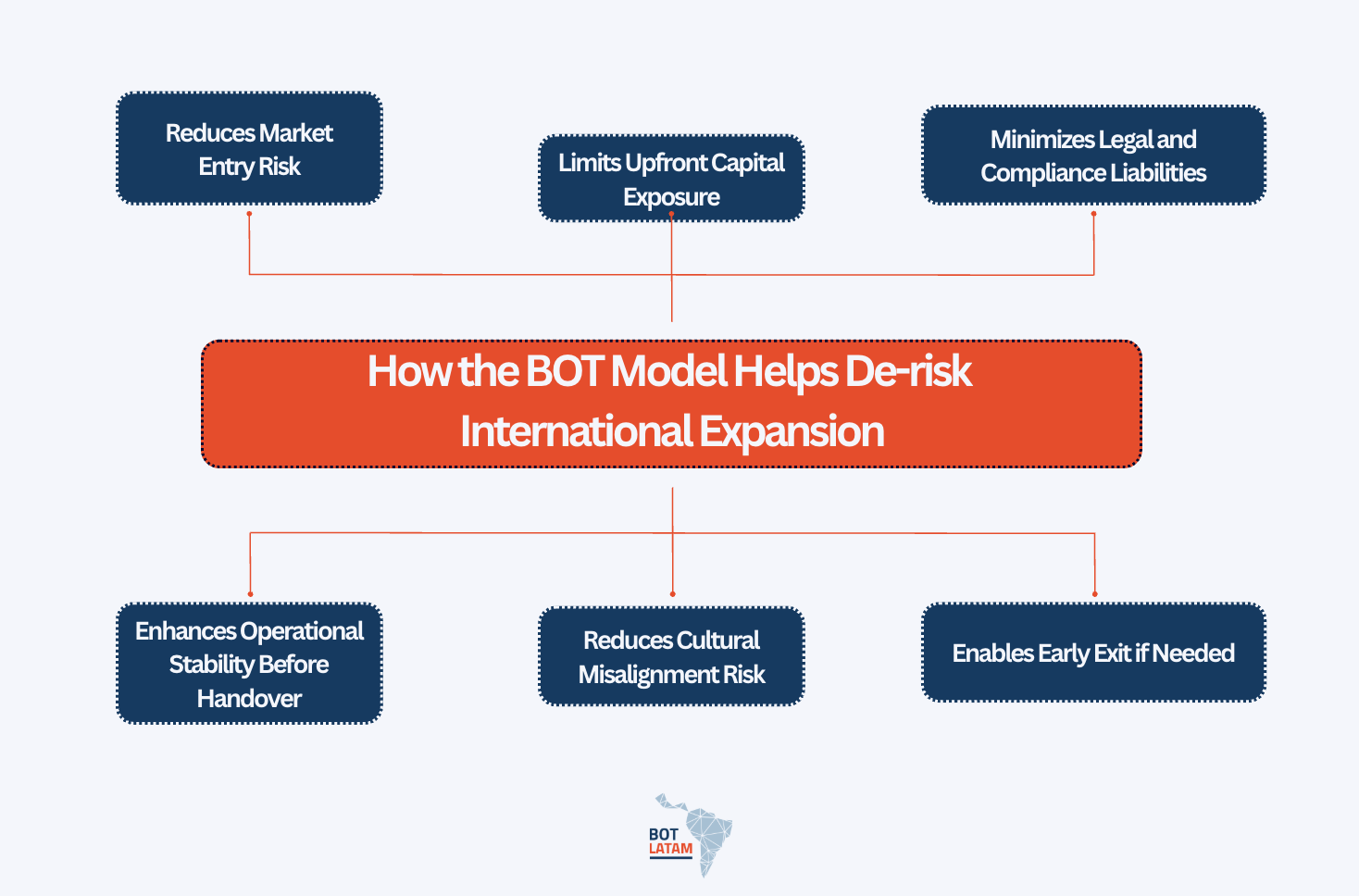Expanding into new markets is exciting, but risky. Legal uncertainty, talent gaps, and infrastructure costs can turn even the best-laid plans into a mess. That’s where Build-Operate-Transfer (BOT) comes in. The BOT model gives companies a way to grow internationally without immediately taking on the full weight of operations. You get the advantage of a local partner who builds and runs the business unit first, then hands it over when it’s stable.
According to McKinsey, companies that partner with local operators during expansion can reduce time-to-market by up to 40%. It’s not just faster, it’s safer. But why exactly? We’re here to help you find out. This article breaks down how the BOT model helps de-risk business expansion, from managing compliance and IP to scaling global teams. You’ll learn about BOT risk management strategies, real-world success stories, and how to decide if this model fits your growth plans. Keep reading to learn more!
How the BOT Model Helps De-risk International Expansion

The Build-Operate-Transfer (BOT) model helps you reduce exposure when entering unfamiliar markets. Instead of taking on full responsibility from day one, you partner with a local team that builds and operates your business unit until it's ready for a smooth transition. This structure removes many early-stage risks that typically cause delays or failure.
1. Reduces Market Entry Risk:
International markets come with regulatory complexity, cultural differences, and operational hurdles. With BOT, these are absorbed by the local operator in the initial “Build” and “Operate” phases. You avoid missteps with labor laws, permits, or vendor contracts because the setup is handled by a partner that already understands the market. In regions like Latin America, where labor regulations shift between provinces or states, this kind of local expertise is essential.
2. Limits Upfront Capital Exposure:
Instead of investing in infrastructure, recruitment, and operations immediately, the BOT model allows you to delay large capital expenditures. You only assume full control after the “Transfer” phase, when the business unit is fully operational and generating value. This staged investment approach helps limit financial exposure. According to Deloitte, companies that adopt gradual investment strategies in global expansion reduce failure rates by nearly 28%.
3. Minimizes Legal and Compliance Liabilities:
In emerging markets, compliance is one of the biggest risks. Local tax codes, employment laws, data protection standards, and business licenses can derail operations fast. Under the BOT model, your local partner assumes responsibility for staying compliant during the operational phase. You inherit a compliant structure, rather than having to build one from scratch. This also reduces the risk of penalties, audits, or shutdowns.
4. Enhances Operational Stability Before Handover:
With BOT, you don’t inherit chaos. The local partner runs the business for a fixed period, stabilizing workflows, setting up standard operating procedures (SOPs), and refining management practices. When the handoff happens, you're not starting from scratch, you're stepping into a fully functioning, low-risk operation. This structure is especially helpful in markets with high employee turnover or fragmented infrastructure.
5. Reduces Cultural Misalignment Risk:
Cultural friction can slow down global teams, impact retention, and damage client relationships. During the “Operate” phase, local professionals run the business with a deep understanding of cultural norms, communication styles, and management expectations. By the time you take over, the team is already aligned, trained, and integrated into the parent company’s goals, without the early growing pains.
6. Enables Early Exits if Needed:
Unlike joint ventures or direct subsidiaries, the BOT model allows for cleaner exits. If the market proves unviable or if business priorities change, you’re not stuck with long-term infrastructure, leased offices, or legal liabilities. Because the business unit is technically still owned and operated by your partner during the early phases, you can choose not to proceed with the transfer.
Risk Management Tools of The BOT Model
The Build-Operate-Transfer model offers built-in risk management tools designed to help you control exposure at every stage of international expansion. These tools give you better visibility, more operational control, and a framework for avoiding common pitfalls when entering unfamiliar markets.
Phased Ownership Structure.
The BOT model breaks expansion into three controlled stages: build, operate, and transfer. This staged approach lets you monitor progress and performance before fully committing. You avoid owning legal and financial liabilities too early, and can make data-driven decisions at every checkpoint. It’s a structural safeguard, not just a strategy.
Local Entity Shielding.
During the “Build” and “Operate” phases, the entity remains under the control of the local partner. That means you’re shielded from early regulatory missteps, tax liabilities, and employment disputes. In markets with high regulatory volatility, like parts of Southeast Asia or Latin America, this reduces your legal risk significantly.
Predefined SLAs and KPIs.
BOT contracts typically include service-level agreements (SLAs) and performance indicators that are legally binding. These allow you to enforce quality and compliance throughout the operational phase. For example, you can set hard KPIs for talent retention, service delivery, or regulatory compliance, and withhold transfer until they're met. According to EY, companies that implement measurable performance benchmarks during outsourcing see 30% fewer compliance violations.
Contractual Exit Clauses.
Unlike joint ventures or wholly owned subsidiaries, BOT agreements often include structured exit clauses. If benchmarks aren’t met, or if market conditions shift, you can back out before the transfer phase. This reduces financial exposure and protects you from long-term commitments in risky regions.
Compliance Monitoring Systems.
Leading BOT providers use automated tools to manage tax filings, labor law adherence, data protection regulations, and entity audits. You benefit from these systems without needing to set them up yourself. Real-time dashboards and audit trails also help track compliance status over time, keeping you informed without overwhelming your internal team.
IP and Data Protection Frameworks.
A major risk in global expansion is intellectual property theft or data leaks. The BOT model includes frameworks for data governance and IP security. Ownership rights, software licenses, and data handling protocols are clearly defined before transfer. In jurisdictions with weak enforcement, such as some emerging markets, this level of protection is critical.
Talent Risk Controls.
BOT structures also help manage hiring risk. Local teams are recruited and tested during the operational phase, reducing the chance of turnover or misfit hires post-transfer. You also gain insight into local salary norms, labor expectations, and HR risks before assuming direct payroll responsibility.
Third-Party Auditing.
Many BOT contracts allow or require third-party audits during the operate phase. These audits assess financial integrity, legal compliance, cybersecurity posture, and HR practices. Independent validation adds a layer of trust and transparency, especially in cross-border operations.
9 Tips to De-Risk Your Expansion Through the BOT Model
Using the Build-Operate-Transfer model can drastically reduce the risks of global expansion, but only if it’s executed with precision. These actionable tips help strengthen your risk management strategy and make the most of the BOT structure.
1. Choose the Right Local Partner:
Vetting your local operator is non-negotiable. Look for a partner with a proven track record in the target market, sector-specific experience, and regulatory expertise. Ask for audited financials, references, and case studies from past BOT projects. A weak partner introduces more risk than the model removes.
2. Set Clear Transfer Criteria Early:
Ambiguity around the “transfer” phase can lead to delays and legal conflict. Define success metrics upfront, performance KPIs, employee retention targets, infrastructure readiness, and compliance benchmarks. Outline what must be in place before the handoff, and include this in the contract.
3. Structure a Flexible BOT Agreement:
Include exit clauses, renegotiation windows, and timeline adjustments. Markets shift, and your business priorities may evolve. A rigid BOT structure can create unnecessary liability.
4. Involve Your Internal Team Early:
Don’t treat the BOT project as a black box. Assign internal leads from operations, legal, HR, and IT to shadow the process. This builds institutional knowledge and smooths the eventual transfer. The earlier your team understands local systems and people, the lower the friction at handover.
5. Monitor Compliance Proactively:
You can't assume the local partner is always aligned with your compliance standards. Set up regular audits, legal, tax, labor, and cybersecurity. Use third-party validators where needed. In high-risk countries, one misstep can stall your expansion for months or lead to fines.
6. Protect Your IP From Day One:
All software, data, branding, and internal processes must be governed by strong IP clauses. Register trademarks locally and make sure data storage and transfer policies are GDPR or equivalent-compliant. Weak IP protections are a known failure point in BOT deals, particularly in regions with poor enforcement.
7. Localize HR Policies in Advance:
Use the “operate” phase to refine localized employment policies, compensation structures, and employee engagement strategies. Labor laws and cultural expectations vary widely. According to the World Bank’s “Doing Business” report, hiring and firing rigidity is still a leading challenge in emerging markets.
8. Don’t Rush the Transfer:
Even if KPIs are met early, resist the urge to speed up the transition. Take the time to perform readiness checks, review documentation, meet key personnel, and ensure tech stacks are compatible. A rushed transfer often leads to integration problems that cost more to fix later.
9. Review Tech Infrastructure Closely:
Legacy systems, unsecured data practices, or incompatible software can create long-term risks. Conduct a full tech audit before transfer. If the BOT partner used shadow IT or workarounds, those can expose you to data breaches or legal claims down the line.
Ready To Expand Through The BOT Model?
We hope this article helped you see why de-risking international expansion isn’t about avoiding risk altogether, it’s about structuring exposure intelligently. The Build-Operate-Transfer model offers a proven framework to enter new markets with more control, less capital at stake, and a clear path to ownership.
At BOT LATAM, we specialize in structuring custom BOT models tailored to high-growth companies expanding into Latin America. Our on-the-ground teams handle local compliance, hiring, infrastructure, and operations, so that when it’s time to transfer, your business unit is stable, scalable, and fully aligned with your standards.
Our approach is built on transparency, governance, and measurable outcomes. If you’re considering a BOT strategy for market entry, contact us! We’ll help you structure the model to avoid common failure points and accelerate your growth with confidence.

Revolutionize Your Workflow with Our Innovative BOT Strategy!
Enhance your operations seamlessly and adapt to market demands
Contact Us



%2017.26.38.png)
